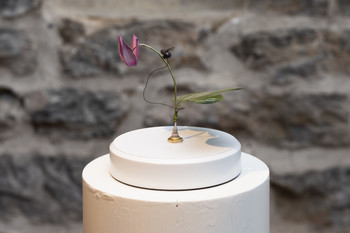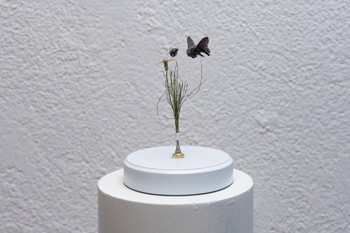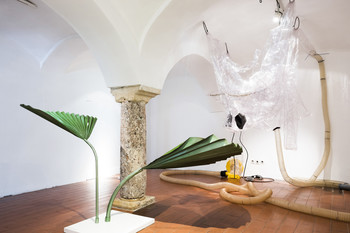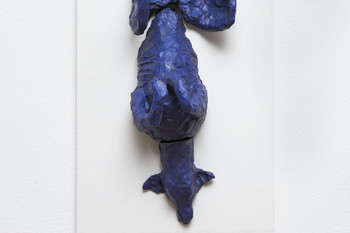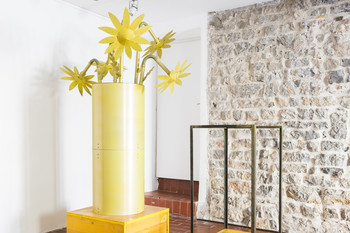Nina Koželj: Good intentions
26. 1. - 17. 3. 2024
Curator: Boštjan Soklič
The Ivan Grohar Gallery presents the works by the contemporary visual artist Nina Koželj. Her spatial organisms, underpinned with irony and bizarre humour, are the result of a successful combination of many skills, expressions and personal messages. Nina Koželj is a visual artist who expands the boundaries of artistic creation, as well as the perception of what art and works of art are in the first place. Her projects, installations, ambient creations and multiples, i.e. several identical art objects, prove that these boundaries cannot - and do not need to - be clearly defined. The focus of her artwork is always on the subject, spiced with a bit of humour. Nina Koželj's oeuvre contains many forms from nature, which are the building blocks of her distinctive aesthetic. When it comes to creating each work, she pays attention to both content and expressiveness in equal measure, working on it in an in-depth and analytical manner. In doing so, she makes great use of her knowledge of technological processes and the properties and functionality of the materials she works with.
The exhibition of Nina Koželj's artwork features a selection of her artistic projects created between 2019 and 2023, as well as her most recent work created especially for this exhibition.
According to the artist herself, the first work - a 2023 installation titled These Flowers Are for You - is a gift for the sullen exhibition visitor. The moment the visitor steps onto the platform in front of the object, a mechanical mediator causes the object to transform - a bouquet of 'withered' flowers suddenly comes to life and stands up straight. The visitor thus becomes an actor in the interaction with the work and the bearer of a particular aesthetic experience. Nina Koželj not only offers a presentation, but also introduces us into the process that turns the work into an event through the viewer's presence. The device that enables a physical connection between the visitor and the installation is a mechanical interface for communication between the sculptural body and the user. Thus, the artist makes the viewer an intense part of her work, while also expanding the space of the artwork and giving it a new presence.
The second installation, Backstroke Swimming, created in 2021, is a wall relief made of glazed ceramic. This realism-based depiction of an animal testifies to the artist's talent for observation and dynamic depiction of animal figurative art with great sculptural and design skill. Nina Koželj focuses on the formal characteristics of the figure with a rich symbolism that offers a myriad of iconographic interpretations.
The second gallery room features an installation titled A Bathing Spot for Small Animals from 2023, made of aluminium, wood and embalmed insects. This installation links Nina Koželj to the projects of established European and American visual artists from the second half of the 20th century (Hirst, Zijstra, Rauschenberg etc.) who incorporated ( or still do) either living or preserved animals in their works. The artist's placement of insects, accidentally caught between the protective metal varnish coating that embalmed the animals, addresses the production of 'ethical' artefacts composed of dead insects. Her haphazard fusion of animal preservation techniques and contemporary art shocks - and perhaps even discomforts - the attentive audience. In any case, the artist achieves her goal, i.e. the viewers' response, thus also raising questions related to the fundamental rights of both humans and animals. A Bathing Spot for Small Animals captures the viewers' attention and can also be seen as a catalyst for dialogue with animal welfare organisations and individuals affected by the subject. In an interesting way, Nina Koželj makes us think about the ethical and moral issues and dilemmas surrounding the use of animals in contemporary art; she makes us muse on whether this might actually be abuse, without regard to the artistic concept and the context of presentation in galleries, museums etc.
In the second gallery room, visitors are confronted with a kinetic ceiling installation titled Stay as Long as You Like: On Breathing, 2019. This is a bulk of inflatable plastic connected to an electric motor that inflates it with air, giving it shape and activating it Without air supply, the spatial organism resembles a skinned mutant from an alien galaxy. As such, it blurs the dividing line between an organism and a machine, between the physical and the non-physical, the natural and the artificial. Standing in front of us is a cybernetic creature, a cross between a machine and an imitation of a real being, which could have come out of science fiction or the technoscientific realm inhabited by cyborgs and similar entities. The animated plastic bulk represents an undefined type of insect - a grasping, tentacled insect that grasps its way around its habitat with its feelers, tentacles, legs or fingers. In the viewers' eyes, the animal-like creature comes to life, but due to an organic aversion to the annoying arthropods and the size of the mass, it may make the viewers feel uncomfortable. The insect's low "breathing" rate (lower than the human respiratory rate of 12 - 20 breaths per minute) may also disturb the viewers, but not necessarily. The "insect" encourages reflection on the capabilities of "smart" machines with human traits (artificial intelligence) and the discomfort of using a machine in a human way.
Sixty Seconds is an art installation made especially for this exhibition. It consists of three units, which differ in the central supports and added preserved insects (a hornet, a violet carpenter bee, a housefly). The work is indirectly related to the activity that deals with the dead bodies of animals for the needs of preserving and using them in artistic projects - taxidermy. Each unit consists of two parts: a flower and a real insect A flower made of thin lacquered aluminium sheet and wire is a memorial, a kind of miniature monument that imitates a real flower in both form and content. The first unit of the spatial "triptych'' is a daisy with a violet carpenter bee, the second is a cyclamen with a housefly, and the third is a dandelion with a hornet (a headless one). Form- wise Sixty Seconds is simple, content-wise, however, it is a complex installation that is actually made up of three "timepieces" - simple dial-less and hand-less clocks, constructed from insects, cylindrical bases and clock mechanisms operating at a frequency of one second. The mechanisms are silent, yet stepwise, i.e. they jump six degrees to the right every second, thus setting in motion the delicately attached animal bodies. The installation is tied to different interpretations of the concept of time as a physical category, however, it comes closest to Aristotle's interpretation, according to which time is just the number of movements (arithmos) with respect to a before and an after.
With her selected projects on view at the Ivan Grohar Gallery, the contemporary visual artist Nina Koželj transforms the exhibition venue into a lively and unusual communication arena, introducing surprising and lucid elements. Using one-of-a-kind interactive approaches, she brings freshness, a special kind of humour, collaboration and experimentalism into the wider Slovenian contemporary art scene, and she does so in a confident, meaningful and witty way. Nina Koželj creates dear and concrete works in any media she works with, building on her expressivity and developing new directions within contemporary visual practices.
Nina Koželj
Nina Koželj (1985) is an artist active in sculpture, printmalding and spatial installations. Her oeuvre is characterised by sculptures whose content is clear, concrete (and often humorous), the artistic motif is unambiguous and the artistic language is often dictated by the choice of material and technique. After graduating from the Secondary School for Design and Photography Ljubljana (SSOF), she enrolled at the Department of Art Education at the Faculty of Education in Ljubljana. Over the years, she has had numerous group and solo exhibitions in Slovenia and elsewhere. In 2016, she participated in the U3 Triennial of Contemporary Slovenian Art at the Museum of Modern Art in Ljubljana, in 2010, she was awarded a scholarship from the Swiss Vordemberge-Gildewart Foundation, in 2021, she received the Young Artist Award by Etike(te) and in 2023, she won the Young Artist Award by Majski salon. She lives and works in Stahovica near Kamnik.
Accompanying programme
- a guided tour of the exhibition with the artist and curator: Thursday, 8th of February 2024 at 4pm.


